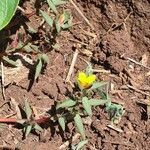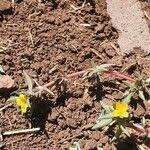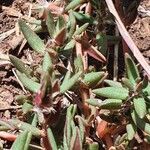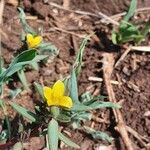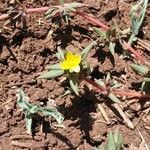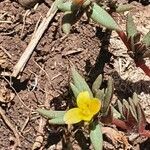Annual herb; stems prostrate, much-branched, to ca. 14 cm long, weak and filiform, 0.5 mm wide, glabrous, creeping and rooting at nodes, forming rooting mats, with nodal tufts of to 2 mm long hairs. Leaves opposite; blade flat, obovate, elliptical, lanceolate or ovate, 2-12 x 1-6 mm (typically 4 x 2 mm in the Guianas), obtuse or acute at apex. Inflorescence of 1-2(-3) terminal flowers, surrounded by long white hairs and an involucre of 4-5 triangular, obtuse, membranaceous, 2-3 mm long leaves; flowers pedicellate. Sepals subequal, triangular-oblong, 2-3.5 x 2 mm, apex obtuse-rounded; petals yellow, elliptical or ovate, 3-6 mm long; stamens 7-12, filaments pilose, anthers more or less suborbicular; ovary conical-ovoid, style 2.5-3.5 mm long, 3-to 4-branched, stigmas ca. 0.5 mm long. Fruit ovoid, to 6 x 0.5 mm, circumscissile in lower third, operculum tubular-campanulate, 1.5-2.5 mm wide; seeds bluish-grey, 0.8-1.0 mm wide, densely granular-or spiny-tuberculate.
Creeping herb, rooting at the nodes; nodes with a whorl of hairs. Leaves elliptic to cordate, 2-20 by 0.8-7 mm with c. 5 mm long axillary hairs. Flowers terminal, l(-3) on an infundibuliform, profusely hairy stem-apex, at edge with 4, seldom more leaves. Sepals c. 3 mm long. Petals 4, obovate, up to 5 by 4 mm, yellow. Stamens 8 or 12; filaments up to 3½ mm; anthers c. 0.30 by 0.30 mm. Style up to c. 4 mm with (3-)4(-5) arms. Fruit ± obovate, up to c. 2-3½ by 3 mm; operculum c.⅔ the height, shining, straw-yellow. Seeds ∞, 0.8-1 mm ø, dull; testa cells elliptic, radially arranged, the surface either convex or with a pyramidal tubercle.
Herbs annual. Stems articulated, prostrate, rooting at nodes; leaf axils patent pilose. Leaves opposite; petiole absent; leaf blade flat, ovate, obovate, or ovate-elliptic, 4-8 × 2-5 mm, slightly narrowed toward base, apex obtuse or acute. Flowers solitary, surrounded by involucre of 4 or 5 bracts, white pilose. Sepals obovate-oblong, 2.5-3 mm, membranous, veined. Petals 4, yellow, oblong or broadly elliptic, 3-6 mm, connate at base, apex mucronate. Stamens 8-10. Ovary ovoid. Stigma (3-or)4-lobed. Capsule globose, ca. 2.5 mm, pericarp membranous. Seeds gray, subglobose, laterally compressed, minute, muricate. Fl. and fr. year-round.
Prostrate, annual herb; stems reddish, rooting at nodes, up to 0.25 m long; taproot stout. Leaves fleshy, elliptic, up to 10 x 4 mm, apex acute, both surfaces ± flattened, venation reticulate, petiolate; stipular hairs light, yellowish brown, many, up to 10 mm long. Flowers mostly solitary at ends of branches, surrounded by 4 relatively large leaves and many hairs. Sepals ± triangular, united at base. Petals 4(5), yellow, orange or pink, 5 x 3 mm, ± elliptic. Flowering time Mar., Apr.? Fruit a conical-ovoid capsule. Seeds many, ± 1 mm in diam., greyish, reniform, verrucose with blunt tubercles.
An annual creeping herb. It is weak and fleshy. The stems curl backwards. They form roots at the nodes. The leaves occur opposite each other. They are flat and oval and 4-8 mm long by 2-5 mm wide. The flowers occur singly at the tips of the branches. There are 4-5 white leaves around them. The flowers are yellow. The fruit capsule is yellow and has a lid. The capsule is 2.5 mm across and round. The seeds are very small.
Leaves opposite; lamina fleshy, up to 10 × 4 mm. but often much less and frequently somewhat shrunk in dried specimens, elliptic, lanceolate, elliptic-oblong or rarely cordate-ovate, apex acute or obtuse, both surfaces more or less flattened; petiole c. 1 mm. long; stipular hairs whitish, numerous, 3–5 mm. long.
Annual herb, up to 0.01 m high. Stems procumbent, with branches up to 0.25 m long succulent Leaves with blade obovate to narrowly obovate, 8-12 x 2-3 mm, stipular hairs many. Flowers: terminal; solitary; corolla deep pink, purple to red or yellow; Nov.-Mar.
Prostrate, succulent herb with branches up to 250 mm long. Leaves flattened, lanceolate-acuminate or elliptic to ovate. Stipular hairs not dilated. Flowers deep pink, purple to red or yellow.
Prostrate annual herb with a somewhat swollen tap-root; stems often reddish and sometimes rooting at the nodes, sometimes reaching 25 cm. long and c. 1 cm. in diam.
Flowers 1–4 at the ends of the branches, surrounded by 4 leaves often somewhat larger than the cauline ones, and by numerous hairs c. 4 mm. long.
Petals 4 (5), yellow or orange or very rarely pink or purplish, almost free, c. 5 × 3 mm., elliptic to ovate.
Ovary conical-ovoid; style c. 5 mm. long, thickened at the apex and with 4 spreading stigmas.
Seeds many, c. 1 mm. in diam., greyish, reniform, verrucose with blunt tubercles.
Sepals 2–4 × 1·5–3·5 mm., ± triangular, obtuse, united at the base.
Capsule conical-ovoid, dehiscing horizontally c. 1/3of the way up.
A prostrate or decumbent herb with pinkish stems
Fleshy leaves very variable in shape size
Conspicuously woolly at the nodes
Flowers yellow.
Stamens 8–12.
